Pecharsky V.K., Zavalij P.Y. Fundamentals of Powder Diffraction and Structural Characterization of Materials
Подождите немного. Документ загружается.

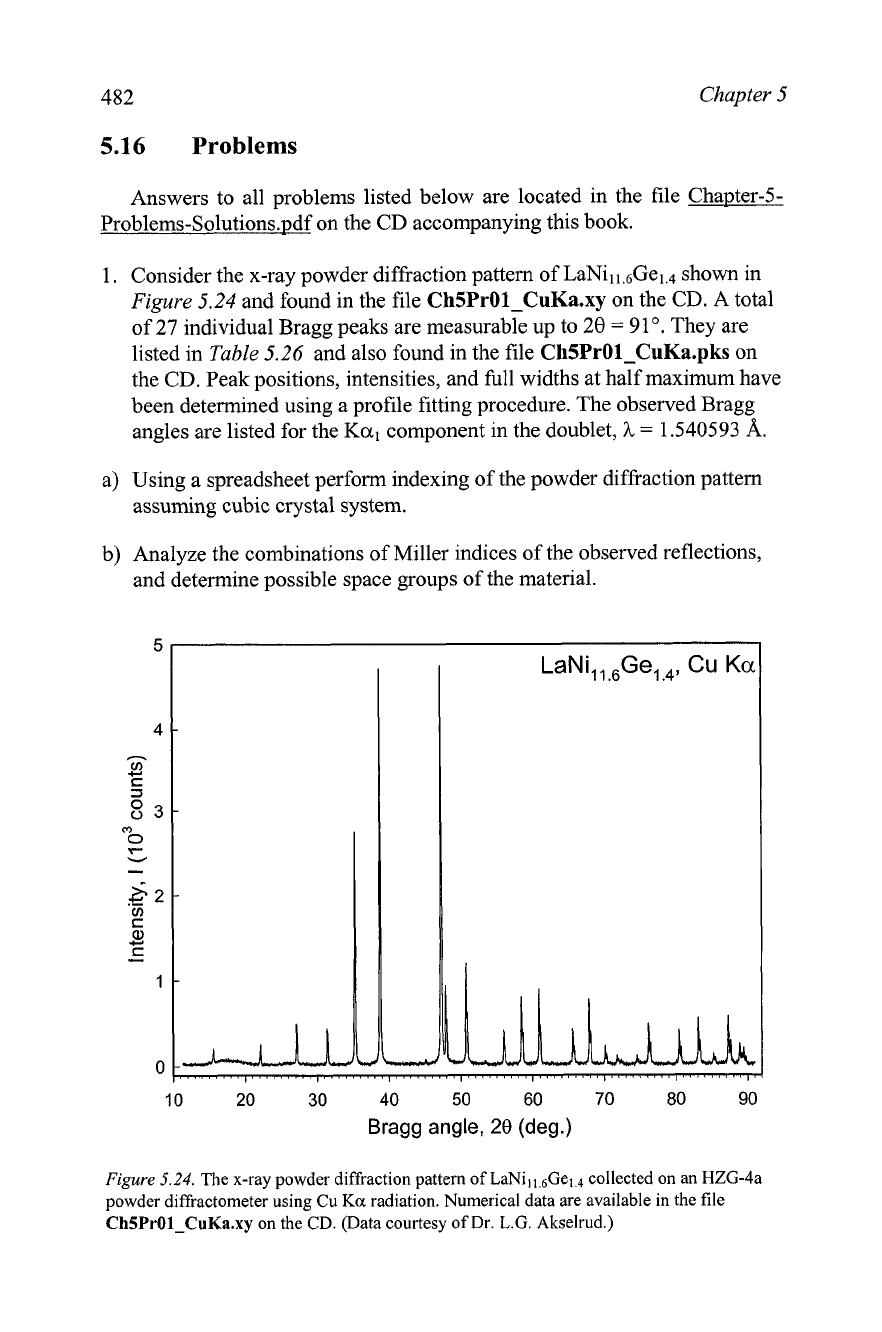
482
Chapter
5
5.16
Problems
Answers to all problems listed below are located in the file Chapter-5-
Problems-Solutions.pdf on the CD accompanying this book.
1.
Consider the x-ray powder diffraction pattern of LaNill,6Gel,4 shown in
Figure
5.24
and found in the file
ChSPrOl-CuKa.xy
on the
CD.
A total
of
27
individual Bragg peaks are measurable up to
28
=
91
".
They are
listed in
Table
5.26
and also found in the file
ChSPrOl-CuKa.pks
on
the CD. Peak positions, intensities, and full widths at half maximum have
been determined using a profile fitting procedure. The observed Bragg
angles are listed for the Kal component in the doublet,
3L
=
1
S40593
A.
a) Using a spreadsheet perform indexing of the powder diffraction pattern
assuming cubic crystal system.
b) Analyze the combinations of Miller indices of the observed reflections,
and determine possible space groups of the material.
5
1
10
20
30
40
50 60
70
80 90
Bragg angle,
29
(deg.)
Figure
5.24.
The x-ray powder diffraction pattern of LaNil,,,Gel,4 collected on an HZG-4a
powder diffractometer using Cu
Ka
radiation. Numerical data are available in the file
ChSPrOl-CuKa.xy
on the CD. (Data courtesy of Dr.
L.G.
Akselrud.)
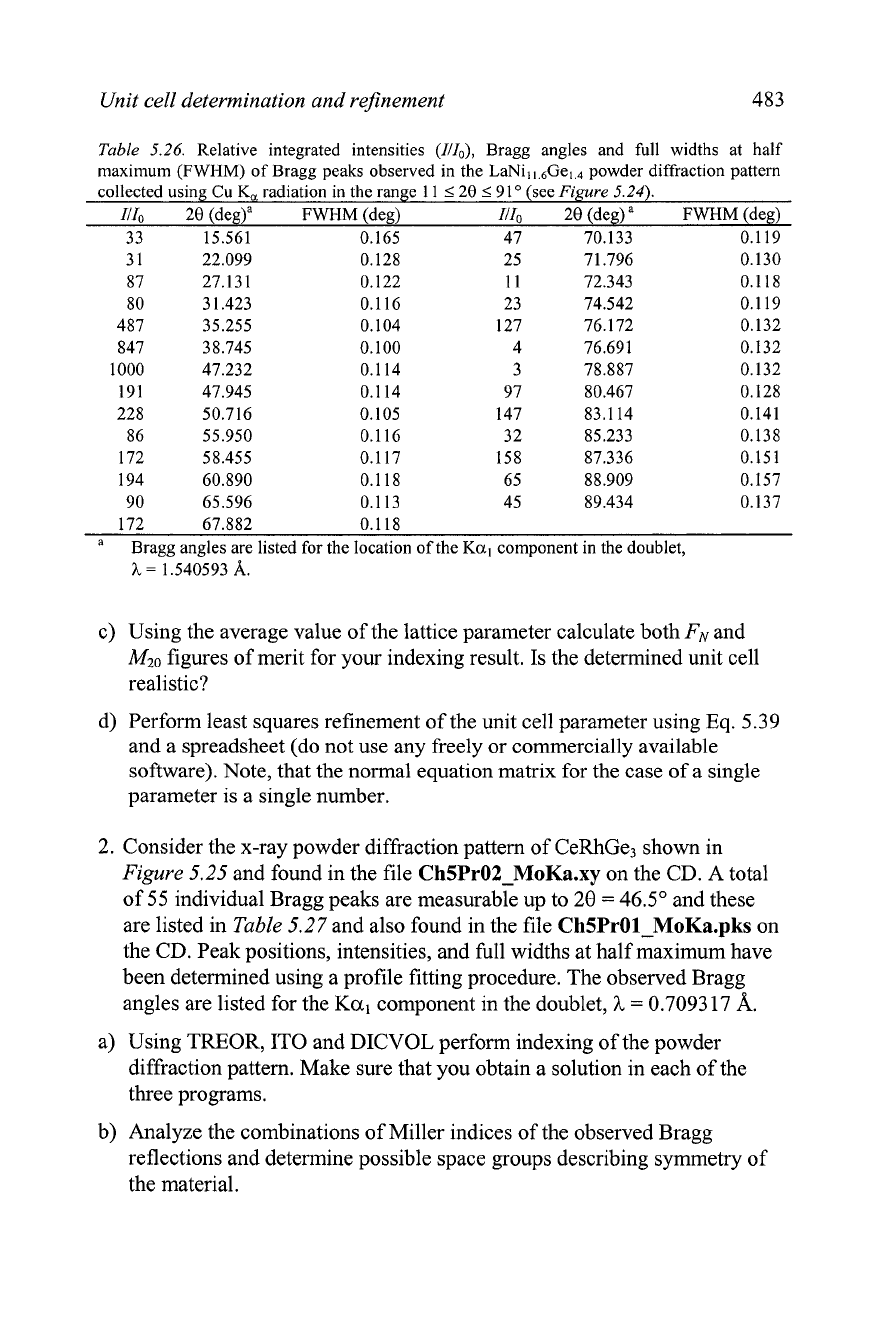
Unit cell determination and reJinement
483
Table
5.26.
Relative integrated intensities (Illo), Bragg angles and full widths at half
maximum
(FWHM)
of Bragg peaks observed in the LaNi, ,.&el powder diffraction pattern
collected using Cu
K,
radiation in the range
1 1
5
28
5
9
lo
(see
Figure
5.24).
IIIo
20
(deg)a
FWHM
(deg) 111,
20
(deg)
a
FWHM
(deg)
3 3 15.561 0.165 47 70.133 0.119
3 1 22.099 0.128 25 71.796 0.130
87 27.131 0.122
11 72.343 0.118
80 3 1.423 0.116
23 74.542 0.119
487 35.255 0.104 127 76.172 0.132
847 38.745 0.100 4 76.691 0.132
1000 47.232 0.114 3 78.887 0.132
191 47.945 0.114 97 80.467 0.128
228 50.716 0.105 147 83.1 14 0.141
86 55.950 0.116 3 2 85.233 0.138
172 58.455 0.117 158 87.336 0.151
194 60.890 0.118 65 88.909 0.157
90 65.596 0.113 45 89.434 0.137
172 67.882 0.118
a
Bragg angles are listed for the location of the
Ka,
component in the doublet,
h
=
1.540593
A.
c) Using the average value of the lattice parameter calculate both
FN
and
Mzo
figures of merit for your indexing result. Is the determined unit cell
realistic?
d) Perform least squares refinement of the unit cell parameter using Eq. 5.39
and a spreadsheet (do not use any freely or commercially available
software). Note, that the normal equation matrix for the case of a single
parameter is a single number.
2.
Consider the x-ray powder diffraction pattern of CeRhGe3 shown in
Figure
5.25
and found in the file
ChSPr02-MoKa.xy
on the CD.
A
total
of 55 individual Bragg peaks are measurable up to
28
=
46.5" and these
are listed in
Table
5.27
and also found in the file
ChSPrOl-MoKa.pks
on
the CD. Peak positions, intensities, and full widths at half maximum have
been determined using a profile fitting procedure. The observed Bragg
angles are listed for the
Ka,
component in the doublet,
=
0.7093 17
A.
a) Using TREOR, IT0 and DICVOL perform indexing of the powder
diffraction pattern. Make sure that you obtain a solution in each of the
three programs.
b) Analyze the combinations of Miller indices of the observed Bragg
reflections and determine possible space groups describing symmetry of
the material.

484
Chapter
5
10 20 30 40
Bragg
angle,
28
(deg.)
Figure
5.25.
The x-ray powder diffraction pattern of CeRhGe3 collected on a Rigaku TTRAX
rotating anode powder diffractometer using Mo Ka radiation. Numerical data are available in
the file
ChSPrOZ-MoKa.xy
on the CD.
c) Perform least squares refinement of the unit cell dimensions using all
available data without reking any kind of a systematic error.' Analyze
the differences between the observed and calculated
28
and decide
whether the refinement of a zero shift or sample displacement error is
warranted. If it is, refine lattice parameters together with a zero shift or
sample displacement error.
3. Consider the x-ray powder diffraction pattern of
SrSiz
shown in
Figure
5.26
and found in the file
ChSPr03-MoKa.xy
on the CD.
A
total of 20
individual Bragg peaks are measurable up to 28
=
33". They are listed in
Table
5.28
and also found in the file
ChSPr03-MoKa.pks
on the CD.
Peak positions, intensities, and full widths at half maximum have been
determined using a profile fitting procedure. The observed Bragg angles
are listed for the
Ka,
component in the doublet,
A
=
0.7093 17
A.
'
If you do not have a preferred least squares refinement software you may download
multiple programs through IUCr or CCP14 Web sites at http://www.iucr.org or
http://www.ccpl4.ac.uk, respectively. One of the simplest to use program, which also
enables one to refine a zero shift parameter, is the UNITCELL.
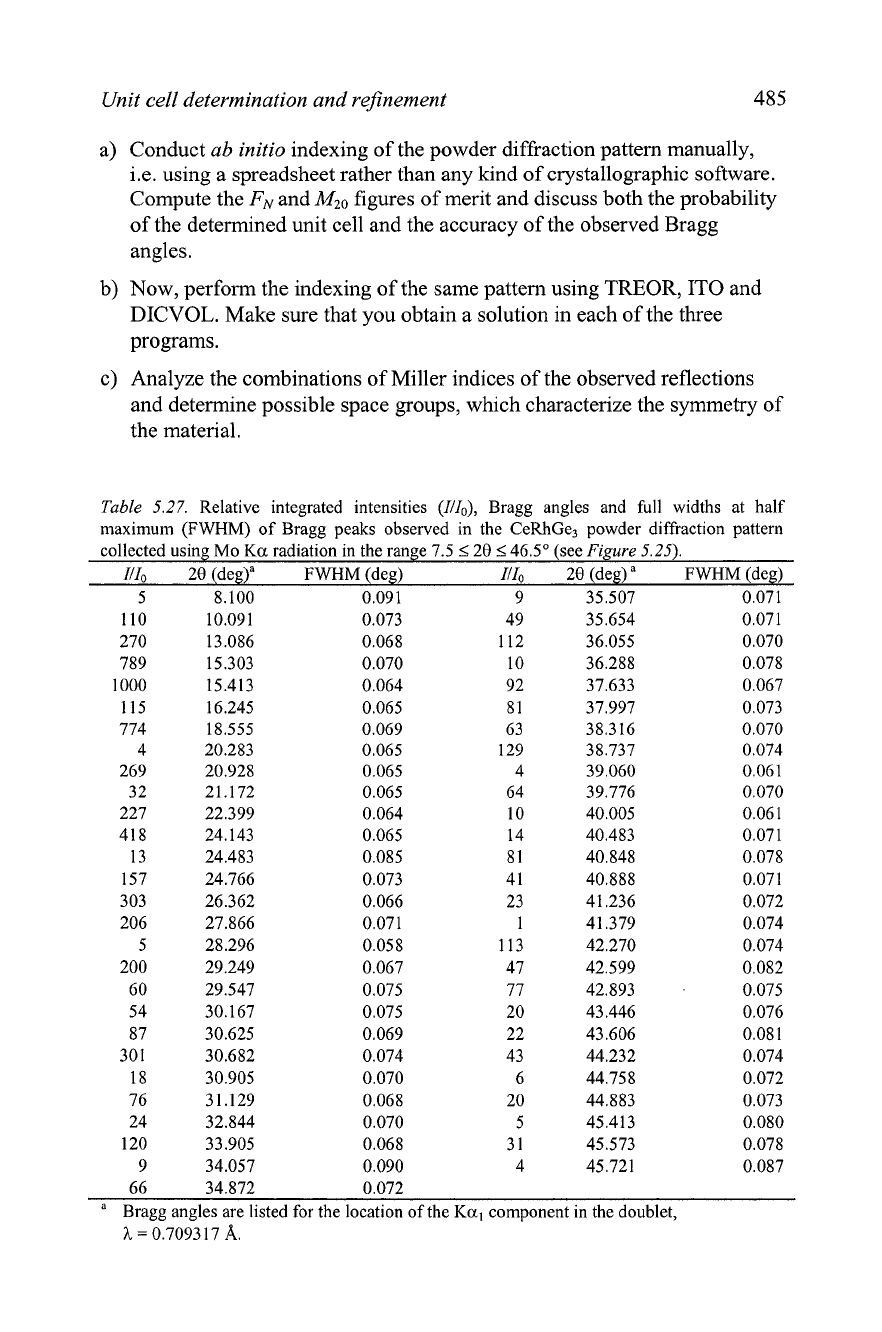
Unit cell determination and refinement
485
a) Conduct
ab
initio
indexing of the powder diffraction pattern manually,
i.e. using a spreadsheet rather than any kind of crystallographic software.
Compute the
FN
and
M20
figures of merit and discuss both the probability
of the determined unit cell and the accuracy of the observed Bragg
angles.
b) Now, perform the indexing of the same pattern using TREOR,
IT0 and
DICVOL. Make sure that you obtain a solution in each of the three
programs.
c) Analyze the combinations of Miller indices of the observed reflections
and determine possible space groups, which characterize the symmetry of
the material.
Table
5.27. Relative integrated intensities (Illo), Bragg angles and full widths at half
maximum (FWHM) of Bragg peaks observed in the CeRhGe, powder diffraction pattern
collected using Mo
Ka
radiation in the range
7.5
2
20
2
46.5"
(see
Figure
5.25).
IlI,
20
(deg)a FWHM (deg) I/Io
20
(deg)
a
FWHM (deg)
5 8.100 0.091 9 35.507 0.071
110
10.091
0.073 49 35.654 0.071
270 13.086 0.068
112 36.055 0.070
789 15.303 0.070
10 36.288 0.078
1000 15.413
0.064
92 37.633 0.067
115
16.245
0.065 8 1 37.997 0.073
774 18.555 0.069 63 38.316 0.070
4 20.283 0.065
129 38.737 0.074
269 20.928 0.065 4 39.060 0.061
3 2 21.172 0.065
64 39.776 0.070
227 22.399 0.064 10 40.005 0.061
418
24.143
0.065
14 40.483 0.071
13 24.483
0.085 8 1 40.848 0.078
157
24.766 0.073
41 40.888 0.071
303 26.362
0.066 23 41.236 0.072
206
27.866 0.071
1 41.379 0.074
5
28.296 0.058
113 42.270 0.074
200 29.249
0.067
47 42.599 0.082
60
29.547 0.075
77 42.893 0.075
54 30. 167
0.075 20 43.446 0.076
87 30.625 0.069 22 43.606 0.081
301 30.682 0.074 43 44.232 0.074
18 30.905 0.070 6 44.758 0.072
76 31.129 0.068 20 44.883 0.073
24
32.844 0.070
5
45.413 0.080
120 33.905
0.068 3
1 45.573
0.078
9
34.057 0.090
4 45.721 0.087
66 34.872 0.072
a
Bragg angles are listed for the location of the
Ka,
component in the doublet,
h
=
0.7093 17
A.

Chapter
5
SrSi,,
Mo
Ka
15
20 25 30
Bragg angle,
28
(deg.)
Figure
5.26.
The x-ray powder diffraction pattern of SrSi, collected on a Rigaku TTRAX
.
.
rotating anode powder diffractometer using Mo
Ka
radiation. Numerical data are available in
the file
ChSPr03-MoKa.xy
on the
CD.
Table
5.28.
Relative integrated intensities (Ill,,), Bragg angles and full widths at half
maximum (FWHM) of Bragg peaks observed in the powder diffraction pattern of SrSiz
collected using Mo
Ka
radiation in the range
8
<
20
<
33'
(see
Figure
5.26).
IIIo
20
(deg)a
FWHM (deg) 111,
20
(deg)
a
FWHM (deg)
80 8.872
0.091 396 23.484
0.079
38 10.851 0.080
101 25.128 0.084
1000
13.999 0.080
5 7 25.912 0.080
626 15.337
0.08
1
72 26.672
0.080
20 17.713
0.08 1 114 27.418
0.076
64
18.794 0.080
200 28.848 0.081
29
19.815 0.079
34 29.540 0.079
203
20.791 0.081
12 3 1.533 0.081
54
21.724 0.076
104 32.170 0.077
70
22.621 0.084
43 32.797 0.076
a
Bragg angles are listed for the location of the Mo
Ka,
component in the doublet,
h
=
0.7093 17
A.
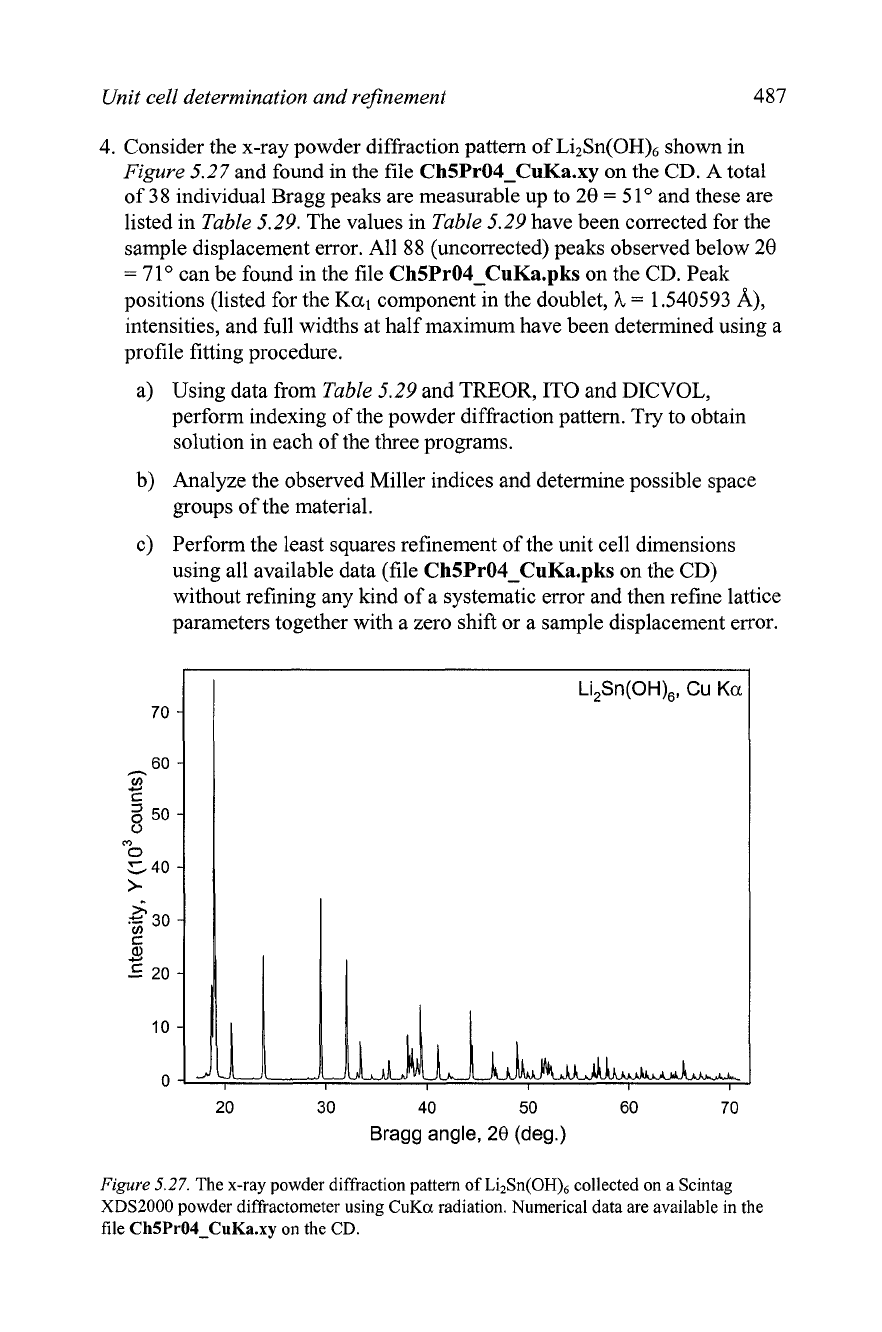
Unit cell determination and rejkemenl
487
4. Consider the x-ray powder diffraction pattern of Li2Sn(OH)6 shown in
Figure
5.27
and found in the file
ChSPr04-CuKa.xy
on the
CD. A
total
of 38 individual Bragg peaks are measurable up to
20
=
5
1" and these are
listed in
Table
5.29.
The values in
Table
5.29
have been corrected for the
sample displacement error. All 88 (uncorrected) peaks observed below
20
=
71" can be found in the file
ChSPr04-CuKa.pks
on the CD. Peak
positions (listed for the
Kal
component in the doublet,
h
=
1.540593
A),
intensities, and full widths at half maximum have been determined using a
profile fitting procedure.
Using data from
Table
5.29
and TREOR, IT0 and DICVOL,
perform indexing of the powder diffraction pattern.
Try
to obtain
solution in each of the three programs.
Analyze the observed Miller indices and determine possible space
groups of the material.
Perform the least squares refinement of the unit cell dimensions
using all available data (file
Ch5Pr04-CuKa.pks
on the CD)
without refining any
kind
of a systematic error and then refine lattice
parameters together with a zero shift or a sample displacement error.
20 30
40
50 60 70
Bragg angle,
28
(deg.)
Figure
5.27.
The x-ray powder diffraction pattern of L~&I(OH)~ collected on a Scintag
XDS2000 powder diffractometer using CuKa radiation. Numerical data are available in the
file
ChSPr04-CuKa.xy
on the CD.
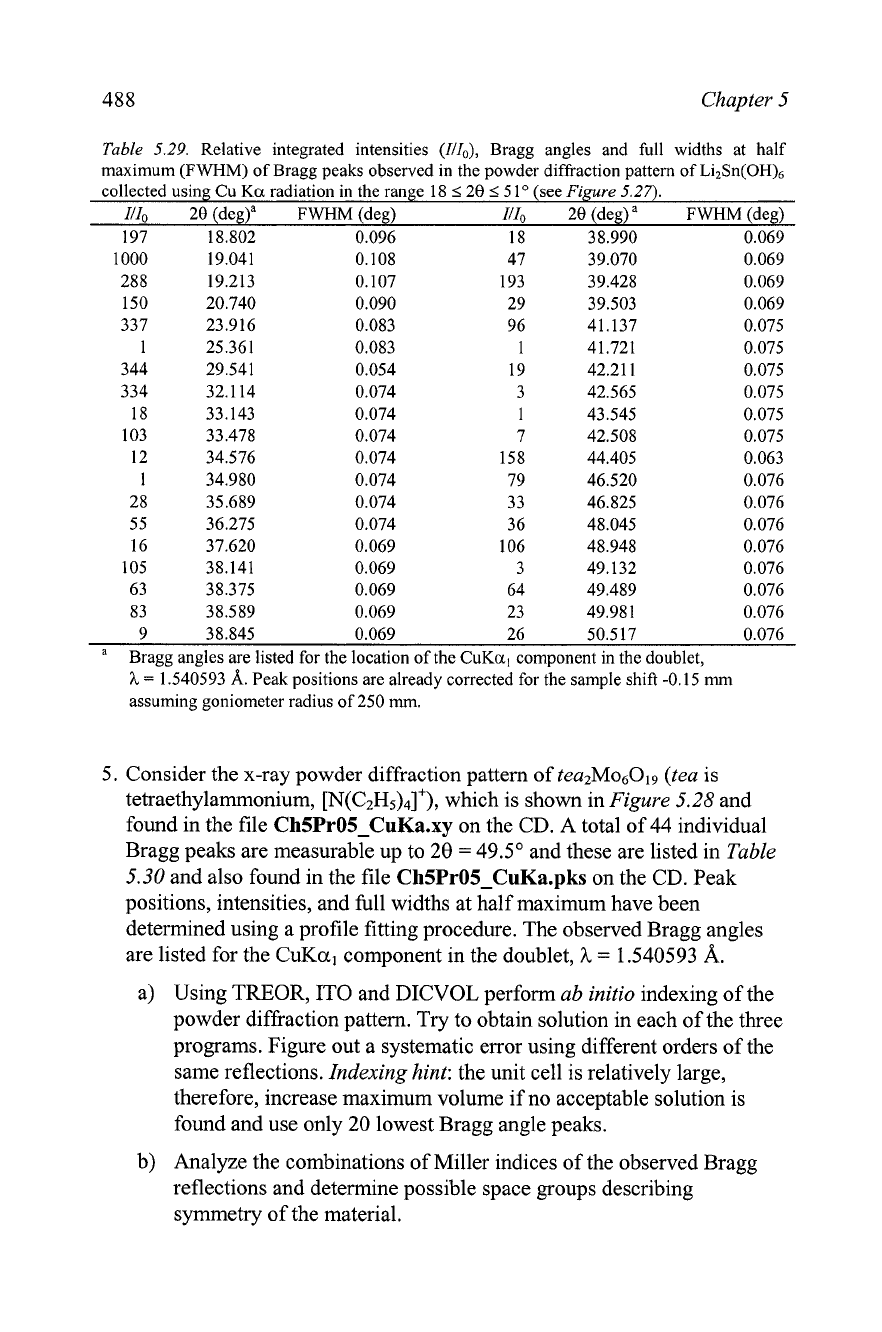
488 Chapter
5
Table
5.29.
Relative integrated intensities (III,), Bragg angles and full widths at half
maximum (FWHM) of Bragg peaks observed in the powder diffraction pattern of Li,Sn(OH),
collected using Cu
Ka
radiation in the range
18
5
20
5
5
1
(see
Figure
5.27).
IlI,
20
(deg)a FWHM (deg) Ill,
20
(deg)
a
FWHM (deg)
197 18.802 0.096 18 38.990 0.069
1000 19.041 0.108 47 39.070 0.069
288 19.213 0.107 193 39.428 0.069
150 20.740 0.090 29 39.503 0.069
337 23.916 0.083 96 41.137 0.075
1
25.361 0.083
1
41.721 0.075
344 29.541 0.054 19 42.21
1
0.075
334 32.1 14 0.074 3 42.565 0.075
18 33.143
0.074
1
43.545
0.075
103 33.478 0.074 7 42.508
0.075
12
34.576 0.074 158 44.405
0.063
1
34.980 0.074 79 46.520
0.076
28 35.689
0.074 33 46.825
0.076
5
5 36.275
0.074 36 48.045
0.076
16 37.620 0.069 106 48.948
0.076
105 38.141 0.069
3
49.132
0.076
63 38.375
0.069 64 49.489
0.076
83 38.589 0.069 23 49.981
0.076
a
Bragg angles are listed for the location of the CuKa, component in the doublet,
h
=
1
.540593
A.
Peak positions are already corrected for the sample shift
-0.15
rnrn
assuming goniometer radius of
250
mrn.
5. Consider the x-ray powder diffraction pattern of tea2Mo6OI9 (tea is
tetraethylarnmonium, [N(Cz~5)4]+), which is shown in Figure
5.28
and
found in the file Ch5PrO5-CuKa.xy on the CD.
A
total of 44 individual
Bragg peaks are measurable up to
20
=
49.5" and these are listed in Table
5.30
and also found in the file Ch5PrO5-CuKa.pks on the CD. Peak
positions, intensities, and full widths at half maximum have been
determined using a profile fitting procedure. The observed Bragg angles
are listed for the CuKa, component in the doublet,
h
=
1.540593
A.
a) Using TREOR, IT0 and DICVOL perform ab initio indexing of the
powder diffraction pattern. Try to obtain solution in each of the three
programs. Figure out a systematic error using different orders of the
same reflections. Indexing hint: the unit cell is relatively large,
therefore, increase maximum volume if no acceptable solution is
found and use only 20 lowest Bragg angle peaks.
b) Analyze the combinations of Miller indices of the observed Bragg
reflections and determine possible space groups describing
symmetry of the material.

Unit cell determination and
refinement
489
10 20 30 40 50
Bragg angle,
28
(deg.)
Figure
5.28.
The x-ray powder diffraction pattern of
collected on a Scintag
XDS2000
powder diffractometer using CuKa radiation. Numerical data are available in the
file
ChSPrOS-CuKa.xy
on
the
CD.
Table
5.30.
Relative integrated intensities (III,), Bragg angles and full widths at half
maximum (FWHM) of Bragg peaks observed in the tea2Mo6Ol9 powder diffraction pattern
collected using Cu Ka radiation in the range
10
5
20
5
49.5"
(see Figure
5.28).
I/Io
20
(deg)a
FWHM (deg)
IlI,
20
(deg)
a
FWHM (deg)
1000 10.241
0.085 52 35.282 0.075
182 11.573 0.070 6 35.425 0.075
65 12.376 0.073 24 35.567 0.075
30 16.408 0.076 24 36.419 0.075
30 16.986 0.076 24 37.259 0.075
4 19.393 0.050 4 37.531 0.075
163 20.6 15 0.074 41 37.798 0.075
14 22.217 0.074 16 39.282 0.071
20 23.297 0.074 19 39.667 0.07 1
17 24.933 0.074 8 40.3 16 0.071
73 25.523 0.074 5 41.842 0.082
155 26.286 0.074 9 41.972 0.082
6 26.479 0.074 5 5 42.355 0.082
22 26.851 0.074 4 42.747 0.082
3 28.138 0.074 3 43.698 0.082
78 28.991 0.074 9 43.824 0.082
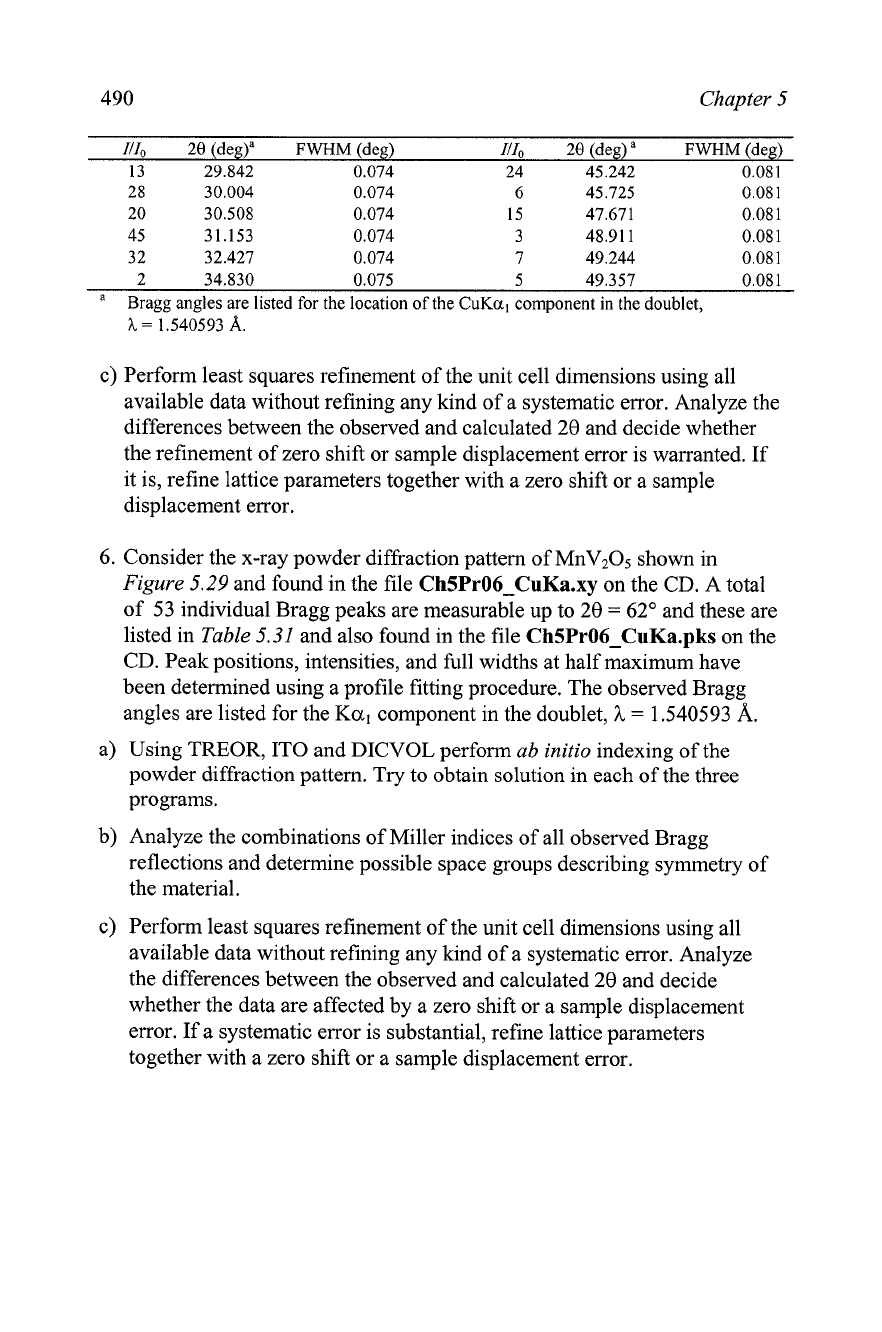
490
Chapter
5
IIIo
20
(deg)"
FWHM
(deg)
111,
20
(deg)
"
FWHM
(deg)
13 29.842 0.074 24 45.242 0.081
2
34.830 0.075 5 49.357 0.081
a
Bragg angles are listed
for
the location of the CuKa, component in the doublet,
c) Perform least squares refinement of the unit cell dimensions using all
available data without refining any kind of a systematic error. Analyze the
differences between the observed and calculated 28 and decide whether
the refinement of zero shift or sample displacement error is warranted. If
it is, refine lattice parameters together with a zero shift or a sample
displacement error.
6. Consider the x-ray powder diffraction pattern of
MnV205 shown in
Figure
5.29
and found in the file
Ch5Pr06-CuKa.xy
on the CD. A total
of
53
individual Bragg peaks are measurable up to 28
=
62" and these are
listed in
Table
5.31
and also found in the file
Ch5Pr06-CuKa.pks
on the
CD. Peak positions, intensities, and full widths at half maximum have
been determined using a profile fitting procedure. The observed Bragg
angles are listed for the
Ka,
component in the doublet,
h
=
1.540593
A.
a) Using TREOR, IT0 and DICVOL perform
ab
initio
indexing of the
powder diffraction pattern. Try to obtain solution in each of the three
programs.
b) Analyze the combinations of Miller indices of all observed Bragg
reflections and determine possible space groups describing symmetry of
the material.
c) Perform least squares refinement of the unit cell dimensions using all
available data without refining any kind of a systematic error. Analyze
the differences between the observed and calculated 28 and decide
whether the data are affected by a zero shift or a sample displacement
error. If a systematic error is substantial, refine lattice parameters
together with a zero shift or a sample displacement error.
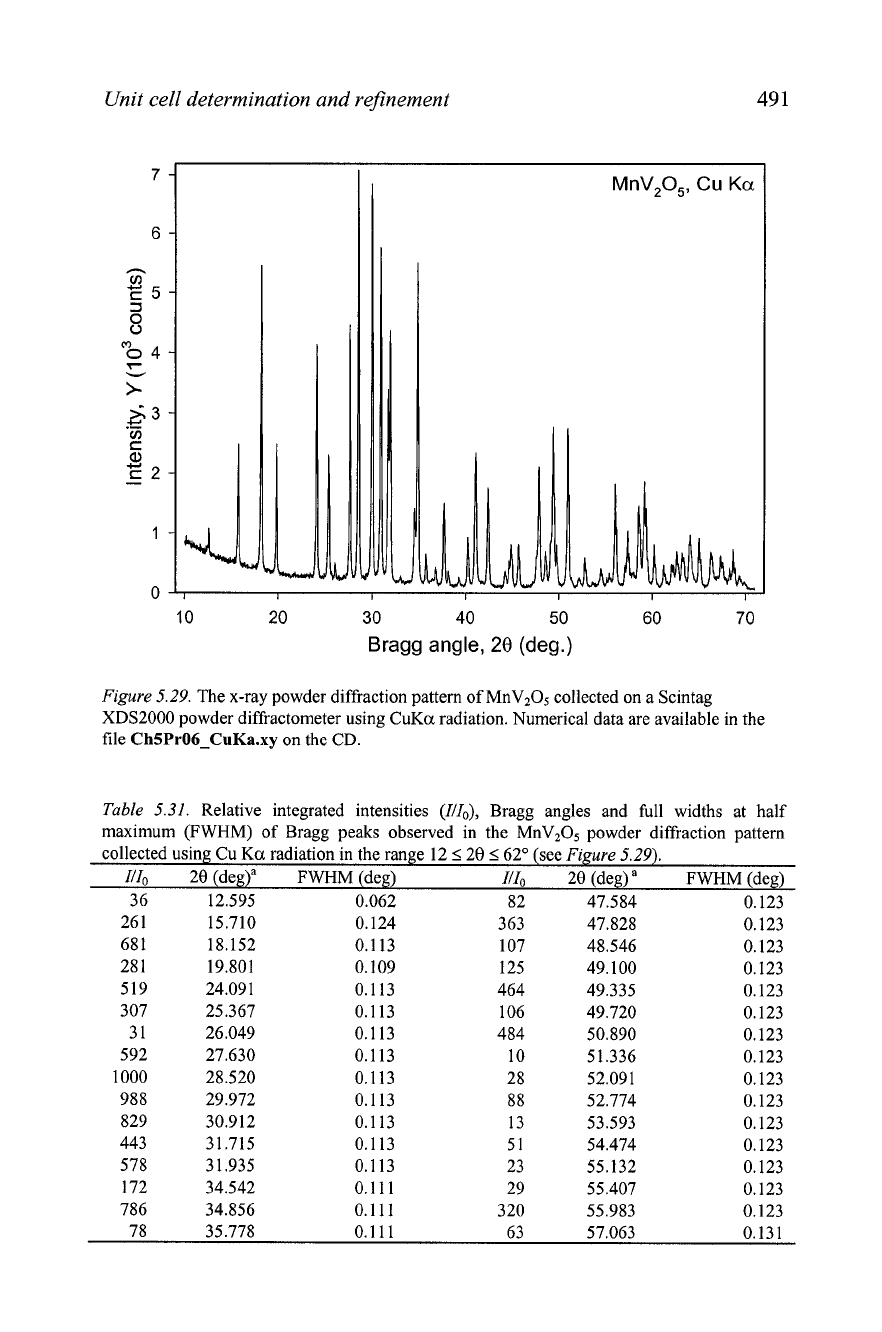
Unit cell determination and rejkement
49
1
10 20
30
40 50 60 70
Bragg angle,
20
(deg.)
Figure
5.29. The x-ray powder diffraction pattern of MnVzOs collected on a Scintag
XDS2000 powder diffractometer using CuKa radiation. Numerical data are available in the
file
ChSPrO6-CuKa.xy
on the CD.
Table
5.31. Relative integrated intensities (Illo), Bragg angles and full widths at half
maximum (FWHM) of Bragg peaks observed in the MnV205 powder diffraction pattern
collected using Cu Ka radiation in the range 12
<
20
<
62"
(see
Figure
5.29).
Illo
20 (deg)a
FWHM (deg)
IIIo 20 (deg)
a
FWHM (deg)
3 6 12.595
0.062
82 47.584 0.123
